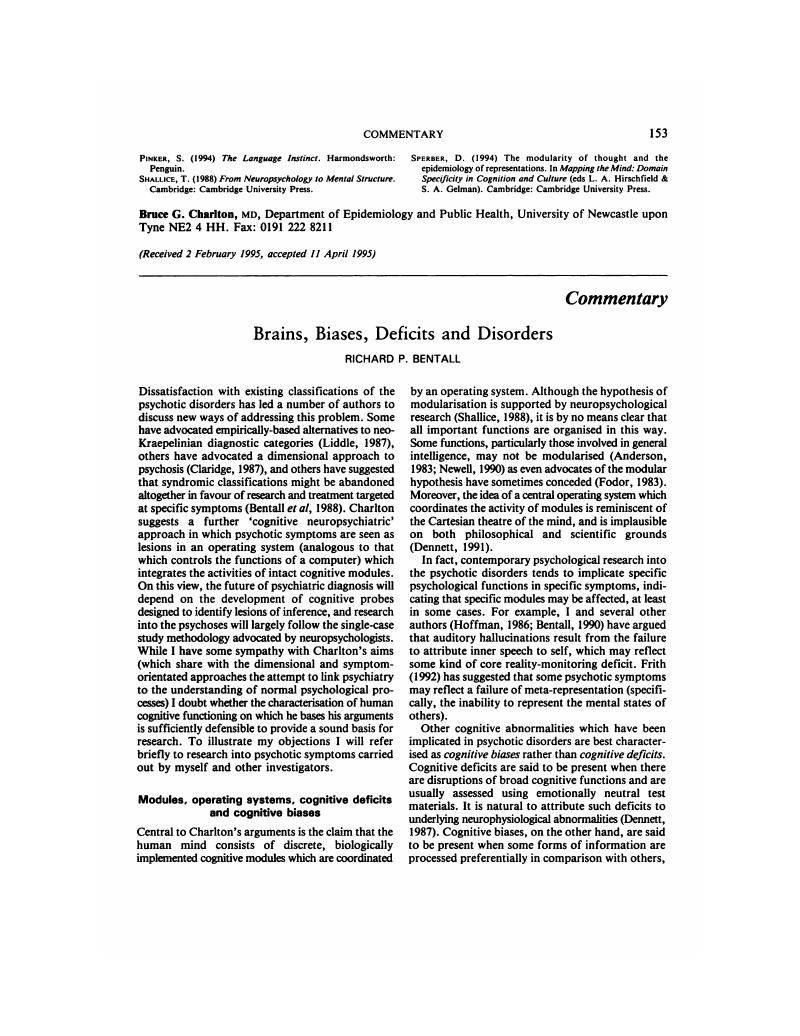Crossref Citations
This article has been cited by the following publications. This list is generated based on data provided by Crossref.
1996.
Editorial.
Cognitive Neuropsychiatry,
Vol. 1,
Issue. 1,
p.
1.
STONE, TONY
and
YOUNG, ANDREW W.
1997.
Delusions and Brain Injury: The Philosophy and Psychology of Belief.
Mind & Language,
Vol. 12,
Issue. 3-4,
p.
327.
Laws, Keith R.
and
McKenna, Peter J.
1997.
Psychotic symptoms and cognitive deficits: What relationship?.
Neurocase,
Vol. 3,
Issue. 1,
p.
41.
David, Anthony
and
Kemp, Roisin
1997.
Five Perspectives on the Phenomenon of Insight in Psychosis.
Psychiatric Annals,
Vol. 27,
Issue. 12,
p.
791.
Kemp, Róisín
Chua, Siew
McKenna, Peter
and
David, Anthony
1997.
Reasoning and delusions.
British Journal of Psychiatry,
Vol. 170,
Issue. 5,
p.
398.
Halligan, Peter W
and
David, Anthony S
2001.
Cognitive neuropsychiatry: towards a scientific psychopathology.
Nature Reviews Neuroscience,
Vol. 2,
Issue. 3,
p.
209.
Dudley, Robert
O'Brien, John
Barnett, Nichola
McGuckin, Liz
and
Britton, Peter
2002.
Distinguishing depression from dementia in later life: a pilot study employing the Emotional Stroop task.
International Journal of Geriatric Psychiatry,
Vol. 17,
Issue. 1,
p.
48.
Broomfield, Niall M.
Davies, Rachel
MacMahon, Kenneth
Ali, Farah
and
Cross, Susan M. B.
2007.
Further evidence of attention bias for negative information in late life depression.
International Journal of Geriatric Psychiatry,
Vol. 22,
Issue. 3,
p.
175.
Langdon, Robyn
2011.
The cognitive neuropsychiatry of delusional belief.
WIREs Cognitive Science,
Vol. 2,
Issue. 5,
p.
449.
Lunt, Laura
Bramham, Jessica
Morris, Robin G.
Bullock, Peter R.
Selway, Richard P.
Xenitidis, Kiriakos
and
David, Anthony S.
2012.
Prefrontal cortex dysfunction and ‘Jumping to Conclusions’: Bias or deficit?.
Journal of Neuropsychology,
Vol. 6,
Issue. 1,
p.
65.
Noordhof, Paul
and
Sullivan-Bissett, Ema
2021.
The clinical significance of anomalous experience in the explanation of monothematic delusions.
Synthese,
Vol. 199,
Issue. 3-4,
p.
10277.
López-Silva, Pablo Andrés
and
Cavieres Fernández, Álvaro Eduardo
2022.
El delirio en la esquizofrenia como objeto de estudio interdisciplinario en la filosofía de la mente.
Sophía,
p.
71.
Raju, Venkateshwarla Rama
2023.
Quantifiable objective psychopathology via cognitive neuropsychiatry: A hybrid-study Part I.
IP Indian Journal of Neurosciences,
Vol. 9,
Issue. 1,
p.
8.
Fuchs, Christina
Silveira, Sarita
Meindl, Thomas
Musil, Richard
Austerschmidt, Kim Laura
Eilert, Dirk W.
Müller, Norbert
Möller, Hans-Jürgen
Engel, Rolf
Reiser, Maximilian
Driessen, Martin
Beblo, Thomas
and
Hennig-Fast, Kristina
2024.
Two Sides of Theory of Mind: Mental State Attribution to Moving Shapes in Paranoid Schizophrenia Is Independent of the Severity of Positive Symptoms.
Brain Sciences,
Vol. 14,
Issue. 5,
p.
461.




eLetters
No eLetters have been published for this article.